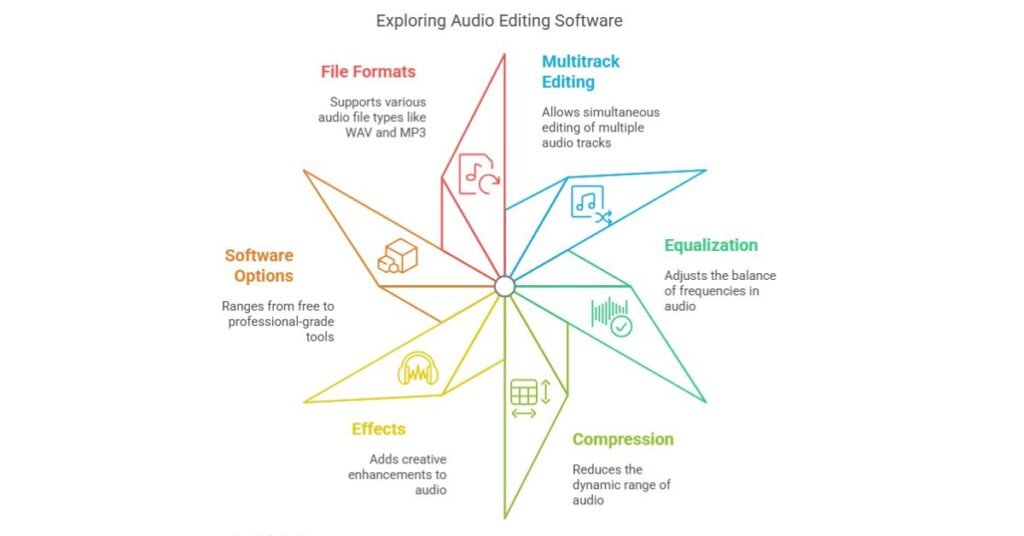Audio editing software is a versatile tool that allows creators to manipulate, improve, and organize sound files. It offers features like multitrack editing, equalization, compression, and effects. From free options like Audacity to professional suites like Adobe Audition, it fits all skill levels and handles formats like WAV or MP3.
Table of Contents
Key Features of Audio Editing Software
Audio editing tools offer a range of key features, such as audio analysis, sound recording and reproduction, auto music generation, and precise volume control. They also support mixing and multitrack editing, making combining and arranging different audio elements easy. Noise filters help clean up recordings by removing unwanted sounds while clipping tools detect and fix distortion. Together, these features provide a complete solution for creating high-quality audio content.
Understanding Audio Files
Audio file formats determine how sound data is stored, compressed, and played back, impacting sound quality and file size. They can be categorized as lossy or lossless. According to Adobe, uncompressed formats like WAV provide the highest quality but are large. Lossy formats like MP3 and AAC compress audio by removing data, resulting in smaller files but potentially lower quality. Lossless formats like FLAC and ALAC compress audio without data loss, offering a balance of quality and file size.
To compare common audio file formats, refer to the table below:
| Audio File Format | Key Characteristics | Impact on Audio Quality |
| WAV | Uncompressed, large files | High fidelity, no loss |
| MP3 | Compressed, smaller size | Good, but some detail lost |
| AAC | Efficient compression | Better than MP3 for streaming |
| FLAC | Lossless compression | High quality with reduced size |
| AIFF | Uncompressed, for Mac | Excellent fidelity, similar to WAV |
How Audio Editing Software Works
While users load audio files, editing software visualizes waveforms as graphical representations, making it easier to trim and adjust. Audio editors process editing audio by enabling users to manipulate these waveforms through tools like cutting, copying, and pasting segments for precise control. They apply effects such as equalization and compression to refine frequencies and dynamics.
Users layer multiple tracks, aligning them on timelines for seamless integration. This interactive approach allows real-time previews, fostering efficient workflows that transform raw recordings into polished audio experiences. Audio editors empower creators to achieve professional results effortlessly.
Types of Audio Editing Software
Audio editing software varies by user needs and capabilities, with options ranging from free, beginner-friendly tools like Audacity to professional suites such as Adobe Audition. Users often choose basic software for simple tasks, like trimming audio tracks, while advanced versions handle complex multitrack arrangements.
This categorization guarantees accessibility for hobbyists, who favor intuitive interfaces, and professionals, who require robust features for precise editing and integration into larger projects.
Popular Audio Editing Software

Several programs dominate the audio editing world, with Audacity leading as a free program. Professionals often choose Adobe Audition for its advanced multitrack capabilities. Other popular audio editing software includes GarageBand and Reaper, known for its versatile, cross-platform appeal. These tools provide accessible features that cater to diverse needs, from novices exploring basic edits to experts demanding robust functionality.
Software Use Cases
Users apply popular audio editing software in everyday scenarios, from podcasters refining episodes with Audacity’s noise reduction to filmmakers mixing tracks in Adobe Audition. In post-production, professionals leverage audio editing software to polish soundtracks for films and TV. Musicians use it to layer tracks and apply effects, while content creators enhance podcasts and social media clips. This versatility supports diverse post-production needs, from documentaries to music production, elevating final outputs effectively.
Pricing Models and Cost-Effectiveness
When considering audio editing software, pricing models vary from free options like Audacity to subscription-based services such as Adobe Audition. Users often compare free tools’ basic features against paid versions’ advanced capabilities. Cost-effectiveness depends on long-term value; for instance, subscriptions provide regular updates and premium effects, while free software suits beginners without ongoing costs. Ultimately, it boils down to balancing features with budget to maximize utility without unnecessary expenses.
Comparing Performance and Ease of Use
This comparison highlights how audio editing software balances speed and capability.
| Software | User Interfaces and Performance |
| Audacity | Intuitive, fast for basics |
| Adobe Audition | Complex, high-power processing |
| GarageBand | User-friendly, seamless on Mac |
| Reaper | Customizable, efficient multi-track |
Advanced Techniques and Best Practices

While mastering advanced techniques in audio editing software, professionals can refine soundscapes for greater impact. They actively use multi-track editing to layer complex audio elements. Advanced techniques like volume automation and precise equalization enhance clarity and emotion. Best practices include regular backups, strategic compression to control dynamics, and noise reduction for polished results. Professionals focus on efficient workflows, ensuring high-fidelity outputs in films and podcasts without overwhelming the original material.
Future Trends in Audio Editing
Emerging technologies are revolutionizing audio editing, with AI-driven tools automating tasks like noise reduction and sound enhancement. Artificial intelligence is transforming how editors handle audio files, enabling real-time analysis and intelligent suggestions for improvements. It’s making complex processes faster, such as detecting and correcting errors in recordings. As AI advances, it integrates seamlessly with cloud-based systems, allowing collaborative editing and predictive enhancements that boost creativity. This evolution promises more accessible, high-quality results, where users achieve professional outcomes with minimal effort, shaping the future of multimedia production.
Choosing the Right Software for Individual Needs
How can individuals pinpoint the ideal audio editing software that fits their unique needs? They start by evaluating their budget, skill level, and project requirements, ensuring the software improves their creative process. For instance, beginners might choose user-friendly options, while pros seek advanced features.
| Software | Best For | Key Features |
| Audacity | Budget Users | Free, Multitrack Editing |
| Adobe Audition | Professionals | Advanced Audio Tools |
| GarageBand | Music Creators | Intuitive Interface |
Frequently Asked Questions
What Hardware Is Required for Audio Editing Software?
Audio editing software demands a reliable computer with a powerful CPU, at least 8GB of RAM, a dedicated audio interface, professional headphones, and external storage.
How Do I Troubleshoot Common Software Glitches?
Users troubleshoot common software glitches by restarting the program, checking for updates, and verifying system requirements. They clear caches, consult online forums, examine error logs, and test hardware compatibility to resolve issues quickly.
Can Audio Software Integrate With Video Editors?
Audio software frequently integrates with video editors, enabling creators to sync sound and visuals seamlessly. For instance, Adobe Audition connects with Premiere Pro, enhancing films and videos by balancing audio elements for immersive storytelling.
What Licenses Apply to Edited Audio Files?
Experts explain that licenses for edited audio files depend on the source’s terms. They often inherit copyrights or require attribution under Creative Commons.
How Often Are Audio Editing Tools Updated?
Audio editing tools undergo updates frequently, with developers like Adobe releasing new versions annually and open-source options like Audacity pushing patches every few months to add features, fix bugs, and improve compatibility.
Conclusion
In summary, audio editing software empowers creators to refine raw recordings into professional soundscapes, blending features like multitrack editing and effects for immersive results. This guide equips users to choose tools like Audacity or Adobe Audition, master techniques, and adapt to future trends, releasing continuous creative potential in an auditory-driven world.







